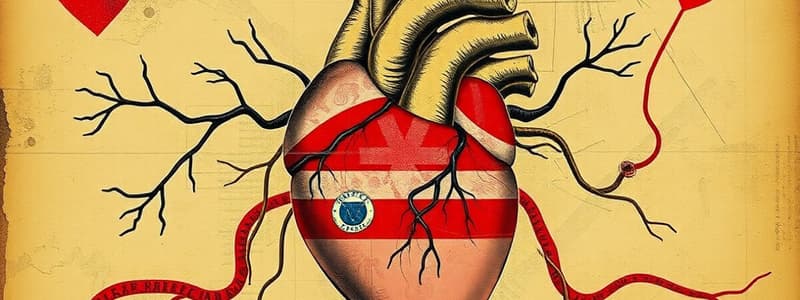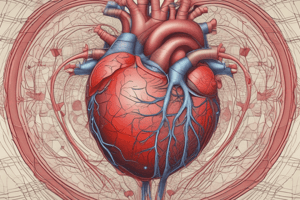Podcast
Questions and Answers
Which of the following correctly completes the sentence: 'The heart is a large ______ and rhythmically, pumping ______ to the arteries to transport it to the body. Inside the heart, the ______ that allow one-way blood flow are found.'?
Which of the following correctly completes the sentence: 'The heart is a large ______ and rhythmically, pumping ______ to the arteries to transport it to the body. Inside the heart, the ______ that allow one-way blood flow are found.'?
- muscle, blood, valves (correct)
- tubes, muscle, valves
- muscle, blood, tubes
- blood, muscle, tubes
In a diagram of the circulatory system, if 'Δ' represents the path where deoxygenated blood is pumped from the right side of the heart to the lungs, what process is occurring?
In a diagram of the circulatory system, if 'Δ' represents the path where deoxygenated blood is pumped from the right side of the heart to the lungs, what process is occurring?
- Hepatic portal circulation, filtering blood from the digestive system.
- Pulmonary circulation, oxygenating the blood. (correct)
- Coronary circulation, nourishing the heart muscle.
- Systemic circulation, delivering oxygen to body tissues.
In a circulatory system diagram, 'A' indicates the path where oxygenated blood is pumped from the heart to the arteries. What is the primary function of this part of the circulatory system?
In a circulatory system diagram, 'A' indicates the path where oxygenated blood is pumped from the heart to the arteries. What is the primary function of this part of the circulatory system?
- To collect deoxygenated blood from the body and return it to the heart.
- To transport oxygenated blood to the lungs for re-oxygenation.
- To filter waste products from the blood in the kidneys.
- To deliver oxygenated blood to the body's tissues and organs. (correct)
If a circulatory system diagram labels certain vessels as containing deoxygenated blood, which of the following statements is most likely true regarding these vessels?
If a circulatory system diagram labels certain vessels as containing deoxygenated blood, which of the following statements is most likely true regarding these vessels?
Consider a diagram of the circulatory system showing arteries, veins, and capillaries. What is the correct order of blood flow through these vessels as it leaves the heart, circulates, and returns to the heart?
Consider a diagram of the circulatory system showing arteries, veins, and capillaries. What is the correct order of blood flow through these vessels as it leaves the heart, circulates, and returns to the heart?
Based on Danai's experiment, which of the individuals displayed the greatest increase in heart rate after physical exercise?
Based on Danai's experiment, which of the individuals displayed the greatest increase in heart rate after physical exercise?
What conclusion can Danai draw from her experiment, considering the limited participant pool and their varied athletic abilities?
What conclusion can Danai draw from her experiment, considering the limited participant pool and their varied athletic abilities?
Why is the absence of a nucleus significant in a mature red blood cell (erythrocyte)?
Why is the absence of a nucleus significant in a mature red blood cell (erythrocyte)?
How do white blood cells (leukocytes) contribute to the body's defense mechanisms?
How do white blood cells (leukocytes) contribute to the body's defense mechanisms?
Which of the following best describes the underlying mechanism of arterial hypertension (high blood pressure)?
Which of the following best describes the underlying mechanism of arterial hypertension (high blood pressure)?
How does myocardial infarction (heart attack) directly impact the heart's function?
How does myocardial infarction (heart attack) directly impact the heart's function?
What is the primary consequence of atherosclerosis (sclerosis of blood vessels) on blood flow and cardiovascular health?
What is the primary consequence of atherosclerosis (sclerosis of blood vessels) on blood flow and cardiovascular health?
Which of the following is a potential consequence of cardiac insufficiency (heart failure)?
Which of the following is a potential consequence of cardiac insufficiency (heart failure)?
Flashcards
What is the heart?
What is the heart?
A large muscle that rhythmically contracts to pump blood throughout the body.
What are heart valves?
What are heart valves?
Structures within the heart that ensure blood flows in only one direction.
What are arteries?
What are arteries?
Blood vessels that carry blood away from the heart.
What are veins?
What are veins?
Signup and view all the flashcards
What are capillaries?
What are capillaries?
Signup and view all the flashcards
Heart Rate
Heart Rate
Signup and view all the flashcards
Red Blood Cells (Erythrocytes)
Red Blood Cells (Erythrocytes)
Signup and view all the flashcards
Cytoplasm
Cytoplasm
Signup and view all the flashcards
White Blood Cells (Leukocytes)
White Blood Cells (Leukocytes)
Signup and view all the flashcards
Arterial Hypertension
Arterial Hypertension
Signup and view all the flashcards
Myocardial Infarction
Myocardial Infarction
Signup and view all the flashcards
Sclerosis of Blood Vessels
Sclerosis of Blood Vessels
Signup and view all the flashcards
Cardiac Insufficiency
Cardiac Insufficiency
Signup and view all the flashcards
Study Notes
- Blood contracts, muscle lengthens, vessels damage, valves constrict.
- The heart is a large muscle.
- The myocardium contracts and expands rhythmically, pumping blood into the arteries to transport it to the body.
- Inside the heart, there are valves that allow one-way blood flow.
Circulatory system diagram information
- Non-oxygenated blood is pumped from the right side of the heart to the lungs.
- Oxygenated blood is pumped from the left side of the heart to the arteries.
Studying That Suits You
Use AI to generate personalized quizzes and flashcards to suit your learning preferences.



